The Economics of Biofuels
Are biofuels the potential solution for global warming and energy dependence?

Are biofuels, like corn, a viable alternative to fossil fuels?
The current Secretary of Energy, Steven Chu, was giving a speech at the World Affairs Council in late 2007. Amongst the crowd were 43 Nobel Laureates, who are working in Chu’s Lab on bioenergy, renewable and global warming. As they listened intently, Professor Chu told the crowd, “We are here because the energy and climate challenges we face require a Manhattan Project approach.”
As Professor Chu implied, the recent dramatic increase in oil prices has raised serious concerns over the sustainability and economic feasibility of fossil fuels as the major source of energy for transport in the future. Combined with our pressing need to reduce greenhouse gas (GHG) emissions, the possibility of biofuels – fuels derived from plant materials – as a major substitute for fossil fuels has increasingly taken the center stage of scientific, economic and policy discussions. For example, legislation has been introduced in the U.S. Congress requires that 80 percent of all cars manufactured or sold in the U.S. to run on ethanol, methanol or biodiesel in addition to regular petrol by 2015.1 In addition, the EU is planning to raise the share of biofuels in transport to 10% by 2020.2
“Increased biofuel production could lead to rising food prices, deforestation, and water shortage among other issues.
Nevertheless, a set of proactive biofuel policy actions also carry their own risks. These include rising food prices, deforestation, water shortage, trade distortion, and inefficient resource allocation as a result of increased biofuel production. Therefore, even though biofuel has the potential to become a solution for high-energy prices and GHG emissions, we need to be very cautious about the possible impacts of adopting biofuels as a major source of energy.
Why Are Biofuels So Attractive to Us?
There are several forces driving the demand for biofuels: surging energy prices, climate change, income and population growth, and globalization. While income and population differ from region to region, climate change is a more universal force. It is important to realize that some factors are also cyclical – the same problems we are encountering now as a result of surging energy prices will haunt us again in the future if we don’t come up with a solution to solve these problems.
The Energy Crisis and Biofuels
One key factor behind rising interest in biofuels as substitutes for fossil fuels is the increasing price of energy. For example, in the ten years between 1998 and 2008, gasoline price as quoted by the Weekly U.S. Gulf Coast Conventional Gasoline Regular Spot Price has increased more than tenfold.
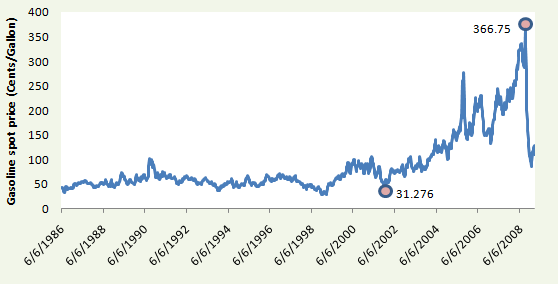
Weekly U.S. Gulf Coast Conventional Gasoline Regular Spot Price FOB (Cents per Gallon). Source: EIA, 2009.3
Although energy prices have fallen since then, we have come to realize that price hikes are cyclical phenomena. Furthermore, it is very likely that gasoline prices will rise on average in the long-term as a consequence of the slow regeneration of fossil fuels, and rapid population and economic growth. Hence, rising energy costs have prompted the investigation of biofuels as a potential substitute for fossil fuels. A study carried out by the Royal Society (2008) has shown that higher oil prices generally make biofuels attractive in many countries. This will continue to be the case, as economies of scale and technological innovations further lower biofuel prices in the future.4
Climate Change and its Implications for Biofuels
Our climate is changing and there is now evidence indicating that this is very likely a consequence of increasing anthropogenic (process derived from human activities) greenhouse gas (GHG) emissions.3b Transport now accounts for about 20% of global GHG emissions; although developing countries are now accounting for a majority of the emissions, the GHG emissions in the United States have been increasing steadily over the years. Biofuels appear to be a solution to this problem, as the carbon they emit to the atmosphere when burned is offset by the carbon that plants absorb from the atmosphere while growing. Because of their potential to improve energy security, many first generation biofuels, especially bioethanol and biodiesel, are already entering the market.

World carbon dioxide emissions from the consumption and flaring of fossil fuels, 1980-2006. Source: EIA, 2009.3
Income and Population Growth
Developing countries experience rapid population and economic growth. With higher incomes, shifting rural-urban populations, and changing consumption patterns, domestic consumer demand for automobiles has increased. As a result, these countries, especially China and India, have a growing appetite for crude oil, and in turn contribute to rising energy prices. Since many of these quickly developing countries are also producers of crops that are feedstock of biofuels, biofuels offer a solution for meeting the energy demands of developing countries.
“Countries have renewed their interest in biofuel production due to surging energy prices.
Because of these many benefits, combined with the recent dramatic surge in energy prices, countries around the world have renewed their interest in biofuel production. However, we should also realize that there are downsides to a comprehensive biofuel policy program. These include rising food prices and inefficient resource allocation.
Sustainability Concerns
Although it is commonly believed that substituting fossil fuels with biofuels would substantially reduce our energy cost, many studies have shown that the actual net economic benefit might not be very large, and it may even be negative. A case study carried out by Nicholas Kukrika (2008) highlights the fixed and variable costs in the first four years during the planting of a 5,000 acre jatropha plantation and biodiesel refining operation when jatropha seeds can be harvested.5
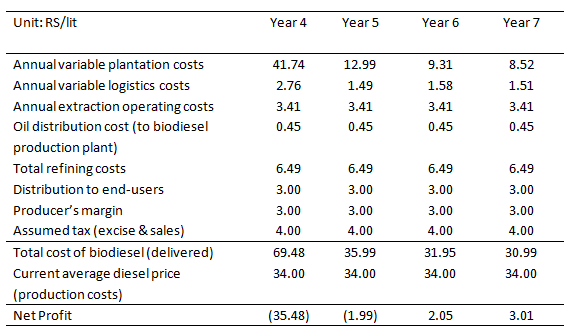
The table shows an on-going cost analysis of biodiesel production costs vs. current diesel prices since April 2007. Source: Nicholas Kukrika, 2008.5
The costs are stated in both absolute and per liter terms. Given that the crop must mature for three years before any seed is harvested, the model assumes that fruits are only harvested beginning in year 4. Therefore, no jatropha oil or biodiesel is produced until the fourth year of operations, assuming the harvest yields ramp up from 1 kg per tree in the first year of harvest (year 4) to 3kgs per tree by year 8. As a result, biodiesel production incurs great financial losses until after the first 2 years of harvest. Even though net profit is positive beginning in year 3, these numbers do not include the overhead costs from the first 3 years of the process. Therefore the paper concludes that, in the case of India, the opportunity cost of growing jatropha is too high and it is unlikely that the 20% biodiesel blending requirement can be met through increased domestic production of biodiesel. In addition, a rising demand for biofuels also increases the demand for their feedstock, which would potentially cause food prices to rise.
Biofuel and Food Price Hikes
As biofuels begin to enter the market and countries devote more of their stocks of natural vegetation and crops to biofuel production, our dependency on this feedstock will also increase. This dependency is expected to become a major new source of demand for these agricultural goods. On the one hand, the introduction of biofuels would reduce energy costs for middle to high-income population. On the other hand, it could also introduce new food-security risks and new challenges for the poor. Trade-offs between food production and biofuel production are inevitable when resources are limited, consequently leading to higher food prices. The eventual impacts of rising food prices are varied for different groups of people.
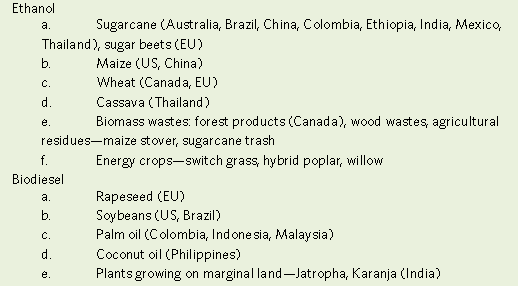
Major sources of feedstock by country. Source: USDA Gain Report (2008).6a
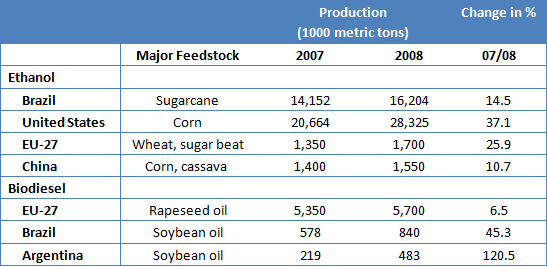
Top biofuel producers and major feedstock used by country. Source: USDA Gain Report (2008)6a, FAPRI projection(2008).7a,7b
While the combined impact of lowered energy costs and increased food costs may be trivial for middle and high-income population, there is growing evidence indicating that biofuels could very well have a net negative impact on poorer populations. For example, low income families, especially those who are net buyers of food, would respond to high food prices with reduced consumption and changed patterns of demand. This would lead such people to become malnourished, while not necessarily benefiting much from reduced energy costs. Amani Elobeid and Chad Hart (2007) have come to a similar conclusion in their study, and they have shown that such a negative impact caused by increased biofuel production is more severe for families in less developed regions.
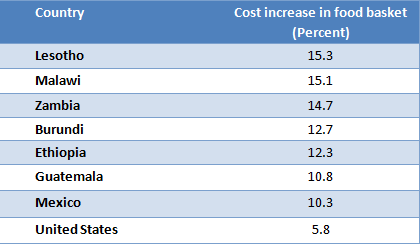
A comparison of the impact of rising oil prices and expansion in ethanol production on food basket cost increases in Africa versus Mexico and the United States. Source: Amani Elobeid and Chad Hart, 2007.8
The effects of feedstock requirements for biofuel production are expected to increase food prices even more in the future. Below are the projected estimates for share output of crops used for biofuel production in 2016.
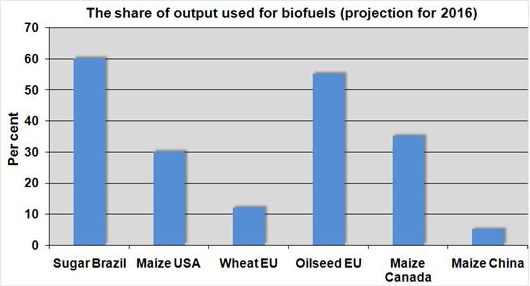
Feedstock requirements for biofuels will become a major new source of demand in the future. Source: SourceOECD, 2008.9
Increased Pressure on Land and Water Supplies
A study by the United States Department of Agriculture (2008) has shown that renewed interest in biofuels has lead to a significant increase in land use for biofuel production.6b As of 2007, total land cultivated in biofuel feedstock amounted to about 47.8 million acres. The United States alone accounted for about 46 percent of the global total, and this number is expected to increase as the U.S. government speeds up its biofuel program and devotes more of its croplands to corn grown for ethanol production. By using a worldwide agricultural model, Searchinger et al. (2008) estimated emissions from land-use change, and they found that corn-based ethanol actually doubles GHG emissions over 30 years and increases GHG for 167 years.10 Another study carried out by the National Academies, Committee on Water Implications of Biofuels Production in the United States (Schnoor et al. 2007) has also found that by shifting agricultural practices to incorporate more biofuel crops would reduce both water quality and water quantity, and in addition, may exacerbate problems associated with fertilizer runoff and soil erosion.11 These results highlight the possible negative impacts on environment as a result of an augmented biofuel program.
Trade Distortions and Policy Implications
To stimulate demand and encourage production of biofuels, many countries are taking ad hoc approaches, such as biofuel subsidies and import restrictions. Historically, both fiscal and regulatory government policies have shaped the demand and production for different commodities. Biofuels are no different, and in recent years, governments across the world have begun to pay more attention to the trading of these renewable energies, as a result of the astronomical oil prices of the recent years. The figure below presents a comparison of tax expenditures on biofuels between fiscal years 1999 and 2007 in the U.S., which shows that total U.S. fiscal spending on biofuel programs has increased fourfold over the years.
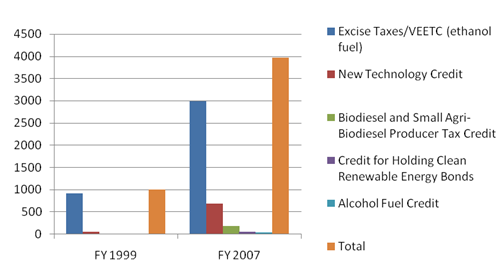
A comparison of tax expenditures on biofuels in the U.S. (million 2007 dollars) Sources: Office of Management and Budget, 2008.12
The two major instruments used by governments to support domestic biofuel production have been import tariffs and production subsidies. Most countries producing bioethanol apply a most-favored nation (MFN) tariff that adds at least 25%, or US$.13/liter, to the cost of imported ethanol. Note that EU and Australia’s tariffs on denatured ethanol add as much as 50% to the import cost.
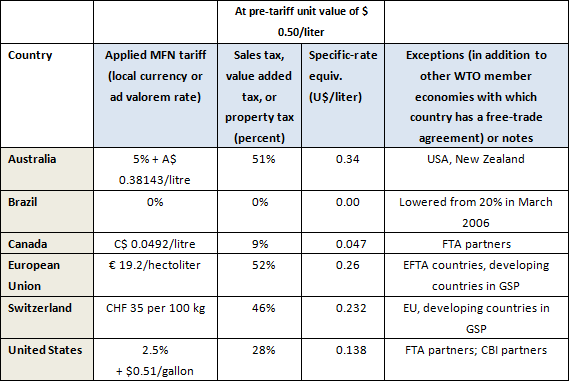
The applied tariffs on undenatured ethyl alcohol (HS 2207.10) in several countries, as of January 1, 2007. Source: Global Subsidies Initiative, 2007.13
While subsidies and trade policies may be able to make domestic biofuel programs more profitable, it might also make them less cost efficient, thereby eventually leading to inefficient allocation of resources in the domestic energy and feedstock markets. For example, instead of importing ethanol made from sugarcane in Brazil, trade restrictions may artificially make domestic ethanol made from corn competitive and more attractive. Although seemingly a conscientious policy, producing ethanol from corn is much more costly and has a much higher impact on feedstock prices. In addition, it might be argued that much more progress would be made only if countries could remove their distortionary policies and use the money saved from them on research for second-generation biofuels. Recent research has shown that second generation biofuels does not compete with food production. The most cited example of a second generation biofuel is cellulosic ethanol, which is derived from “woody” materials such as tree bark. Such biofuel sources may be the key to a more realistic and sustainable biofuel future.
Future and Beyond
The recent price hikes in crude oil prices calls for an immediate policy response. The potential of dramatically reducing energy costs by scaling up biofuel production makes biofuels very attractive to us. However, the complex trade-offs between reduced energy costs and surging food prices, between GHG reduction and land/water depletion, and protectionist policies and free market practices prove that a comprehensive study is needed before any actual biofuel program is taken place. The most important lesson from the recent energy crisis, however, is that we need to take actions that may involve difficult trade-offs. If we do not learn from the energy crisis, we are bound to be struck by it again.
References
1USGPO (United States Government Printing Office). 2009. 110th Congress Senate Bills. Washington, D. C. DOCID: s3303is.txt. Available at: http://frwebgate.access.gpo.gov/cgi-bin/getdoc.cgi?dbname=110_cong_bills&docid=f:s3303is.txt
2Europa. 2007. Renewable Energy Road Map: Renewable energies in the 21st century: building a more sustainable future. European Communities: European Commission.
3aEIA (Energy Information Administration), 2009. Available at: http://www.eia.doe.gov/oiaf/forecasting.html.
3b____. 2009. Greenhouse Gases, Climate Change & Energy. Washington D.C.
4The Royal Society. 2008. Sustainable Biofuels: Prospects and challenges.London,UK.
5Nicholas Kukrika. 2008. Biofuels in India: An overview of the value chain and analysis of biofuels’ pro-poor potential. January 2008
6aUSDA (United States Department of Agriculture). 2008. GAIN Report. Washington D. C.
6b____. 2008. Global agricultural supply and demand: factors contributing to the recent increase in food commodity prices. Washington D. C.
7aFAPRI (Food and Agricultural Policy Research Institute). 2007. FAPRI 2007 U.S. and world agricultural outlook. Ames, Iowa.
7b_____. 2008. FAPRI 2008 U.S. and world agricultural outlook. Ames, Iowa.
8Elobeid, Amani and Hart, Chad. 2007. “Ethanol Expansion in the Food versus Fuel Debate: How Will Developing Countries Fare?,” Journal of Agricultural & Food Industrial Organization: Vol. 5 : Iss. 2, Article 6. DOI: 10.2202/1542-0485.1201.
9SourceOECD. 2008. OECD (Organisation for Economic Co-operation and Development). Paris. Available at: http://puck.sourceoecd.org/vl=3796492/cl=12/nw=1/rpsv/home.htm.
10Searchinger et al. 2008. Use of U.S. Croplands for Biofuels Increases Greenhouse Gases Through Emissions from Land-Use Change. In Science, Vol. 319. No. 5867, pp 1238 -1240, 29 February 2008.
11Schnoor et al. 2007. The National Academies. Water Implications of Biofuels Production in the United States. National Academies Press, Washington, D.C.
12OMB (Office of Management and Budget). 2008. Analytical Perspectives of the United States Budget. Washington. D. C.
13Global Subsidies Initiative. 2007. Biofuels – At What Cost? Government support for ethanol and biodiesel in selected OECD countries. Geneva, Switzerland.
